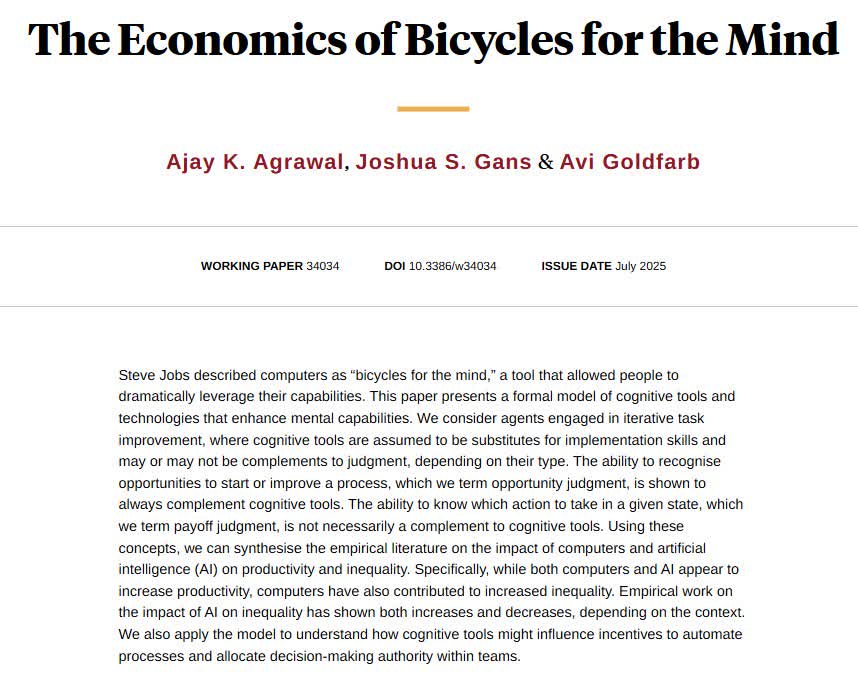
pamela mishkin
@manlikemishap
Followers
319
Following
98
Media
7
Statuses
37
econ research lead @openai, a company is nothing without its workers
Joined November 2023
My guest essay in @nytimes today. I make 5 key points: 1. There’s little clear evidence of AI eliminating jobs at scale yet. But waiting to see is risky. Pittsburgh’s steel towns saw early signs with mini-mills before the losses showed up. Service capitals like London and New
30
169
631
I keep seeing this paper (and the others like it) being misinterpreted. This is a measure of AI applicability, not job loss. That might mean the jobs are at risk, but it also can be the jobs that will be most benefitted by using AI, or those that will be most transformed by it.
25
78
501
Sectors that are more exposed to LLMs experienced significant increases in wages and employment following ChatGPT’s release.
7
59
258
We're introducing GPT-5. The evals are SOTA, but the real story is usefulness. It helps with what people care about-- shipping code, creative writing, and navigating health info-- with more steadiness and less friction. We also cut hallucinations. It's better calibrated, says "I
62
61
904
Today we release gpt-oss-120b and gpt-oss-20b—two open-weight LLMs that deliver strong performance and agentic tool use. Before release, we ran a first of its kind safety analysis where we fine-tuned the models to intentionally maximize their bio and cyber capabilities 🧵
113
382
3K
this kind of robust research -- really focusing on surveys as an eval (SaaE) for impact -- is so badly needed! we can only glean so much from a chat log or even RCT
0
0
2
ai’s “economic impacts” aren’t just productivity gains or layoffs. fear of being replaced + algorithmic bossing ==> despair. and despair begets inefficiency! if you're worried about the job market do you buy a home? change your major? have kids?
1
0
4
cRaZy PaPeR! yet more evidence young workers are feeling despair. why? - social media (“compare-and-despair” effect) - underemployment blues - pandemic burnout & rethinking the grind and turns out they don't like surveillance either!
Despair in the United States now declines with age. This is due to the rise in despair among young workers. Find out more here: https://t.co/IqeBXNvTJC
@nberpubs @UCLSocRes
2
0
5
if you think it's important to ~at least explore~ policies that respond as disruption happens -- automatic stabilizers, targeted support for displaced workers -- you need data! bls gives us the who, doing what, where, for how long of (un)employment.
0
0
0
to be clear, it doesn't mean disruptions don't happen, it means that when they happen policymakers have better data to underpin their response flying blind, great title for a romcom
1
0
0
the bls isn't just some political scoreboard. it has repeatedly served as a leading indicator for big labor market changes: - the China shock to American manufacturing - the "jobless recoveries" after 2008 - the rise of gig work - COVID!
1
0
0
2
0
2
big fan of this work from the microsoft team! what would be great next: * more from more labs on the where/when/who of AI use * experiments to validate how AI use translates to productivity gains * policy proposals for using data from labs as leading indicators of impact
Interestingly, an economics paper that came out in 2023 predicting which jobs would overlap most with AI turned out to be right. A new Microsoft study of actual AI use by workers (more on that in another post) found a 90% correlation between real world overlap & the predictions.
1
5
19
meanwhile, i continue to get a lot of angry messages from mathematicians
0
0
1
love this paper btw! if you're an economist trying to decide what to work on in ai, there's a whole bunch of work on evals for interactions that augment, uplift, and assist to pick up
Modeling computers and AI as cognitive tools provides a lens to interpret evidence on inequality, workflows, and teams, from @professor_ajay, @joshgans, and @avicgoldfarb
https://t.co/gdwIb6lc6o
0
0
2
in a fun coincidence, i had emergency surgery in nairobi a few weeks ago (i'm fine now!), the team's work gave me so much more confidence navigating a foreign health setting and advocating for myself there :)
0
0
1
great work from karan and the team! more in-context studies, more!!
📣 Excited to share our real-world study of an LLM clinical copilot, a collab between @OpenAI and @PendaHealth. Across 39,849 live patient visits, clinicians with AI had a 16% relative reduction in diagnostic errors and a 13% reduction in treatment errors vs. those without. 🧵
1
0
1




























